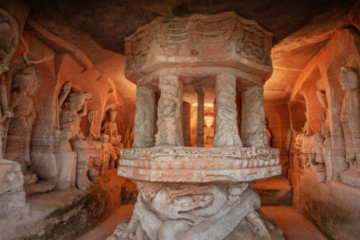The Baodingshan Stone Carvings, located in Dazu District, Chongqing, are an integral part of the renowned Dazu Rock Carvings, which were inscribed on the UNESCO World Heritage List in 1999. These carvings are celebrated for their exceptional artistic value, intricate details, and profound cultural significance. Baodingshan is considered one of the most outstanding examples of Chinese stone carving art from the Song Dynasty.

Baodingshan is situated approximately 15 kilometers northeast of the urban area of Dazu District. The carvings were initiated by Zhao Zhifeng, a monk of the Esoteric Buddhism school, in 1174 during the Southern Song Dynasty. Over a period of 70 years, Zhao Zhifeng and his followers created a vast complex of sculptures and reliefs that cover an area of about 2.5 kilometers. The carvings are divided into several sections, with the most famous being the Dafowan area, which features a continuous expanse of carvings that span approximately 500 meters.
The Baodingshan Stone Carvings are renowned for their rich and diverse content, which includes a wide range of Buddhist themes. The carvings depict various Buddhist deities, bodhisattvas, and scenes from Buddhist scriptures. One of the most notable features of Baodingshan is the integration of Buddhist, Confucian, and Daoist elements, reflecting the coexistence and interaction of these philosophies during the Song Dynasty.
The carvings at Baodingshan are characterized by their exquisite craftsmanship and attention to detail. The figures are depicted with lifelike expressions and intricate attire, showcasing the high level of artistic skill of the sculptors. The carvings also feature a variety of inscriptions, which provide valuable insights into the historical and cultural context of the time.
One of the most famous carvings at Baodingshan is the "Thousand-Armed Guanyin," a bodhisattva with multiple arms, each holding a different object. This carving is renowned for its intricate details and the sense of movement and dynamism it conveys. Another notable work is the "Sutra-Transforming Hall," which features a series of carvings that illustrate the transformation of Buddhist teachings into practical wisdom.
The Baodingshan Stone Carvings also include several unique features that set them apart from other rock carvings in China. The carvings are not only religious in nature but also serve as a form of moral and ethical education. Many of the carvings depict scenes from daily life, illustrating the principles of Buddhism and the importance of compassion, wisdom, and moral conduct.
Visitors to Baodingshan can explore the extensive complex of carvings and reliefs, which are protected by modern facilities to ensure their preservation. The site offers a unique opportunity to experience the rich cultural and artistic heritage of ancient China. The carvings are open to the public daily, with admission fees that support the ongoing conservation efforts.
Baodingshan Stone Carvings are a testament to the artistic and cultural achievements of the Song Dynasty. They offer a profound and captivating glimpse into the spiritual and artistic life of ancient China. Whether you are a scholar of art history, a religious pilgrim, or simply a curious traveler, Baodingshan is sure to leave a lasting impression with its breathtaking beauty and profound cultural significance.




































